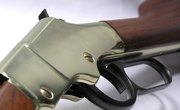A variety of sighting styles exist for shotguns with rifled barrels. Many shotgun hunters equip their shotguns with scopes for deer hunting. But another option is using a rifled barrel with iron sights. Iron sights are very effective for short-range shooting. They are reliable, immune to some of the weather-related problems that plague scopes, and affordable.
Items you will need
Shotgun
Slugs
Target
Shooting bench
Sandbags
Marker
Screwdriver
Sighting In Your Shotgun
Take your shotgun to a shooting range. The range should have a solid shooting bench with sandbags to rest your shotgun on. Bring plenty of shotgun slugs, a paper target, and a marker.
Make sure the range is clear of other shooters. Affix a target to a shooting stand 50 yards from your bench.
Sit at the bench. Prop your gun on the sandbags for steadiness. When the range is clear, announce you are ready to fire. Load the gun.
Train the sights on the bulls-eye. Iron sight styles vary, but many consist of a blade and post. Sight down the barrel. Center the front blade in the notch in the rear post and flush with the top. Click the safety off. Relax and exhale as you gently squeeze the trigger. Engage the safety after you shoot. Fire two more shots.
When the range is clear, examine the target. Find the center point of your three-shot group. If the center is on the bulls-eye and your shots are no more than 3 inches apart, you're done. A 3-inch group is generally acceptable. If you aren't centered on the bulls-eye, note where the gun is shooting.
Circle the shots with the marker so you can identify the group from subsequent holes. Return to the bench.
Examine your sights. Many iron sights have a fixed front sight and a fully adjustable rear sight. Move the rear sight the direction you want your slug to move to hit the bulls-eye. If you shot below the bulls-eye, move the rear sight up. If you shot to the left of the bulls-eye, move the rear sight right. Styles vary, but many simply have a windage screw that moves the sight right or left. A separate elevation screw loosens the sight and allows you to slide it up or down, then retighten it.
Make the necessary adjustments and shoot three more times. There is no exact science to how far moving the sight will move the point of impact, so you may have to repeat the process a few times. Don't over-adjust. A slight adjustment moves the point of impact a lot.
Repeat the process until your three-shot group is centered on the bulls-eye.
Warnings
- Always keep safety in mind. Load the gun only when you're ready to fire, and keep the safety on whenever you're not shooting. Make sure no one is downrange when you're ready to fire and always announce that you are walking downrange if other shooters are present.
- Wear shooting glasses and hearing protection for additional safety.
Warnings
- Always keep safety in mind. Load the gun only when you're ready to fire, and keep the safety on whenever you're not shooting. Make sure no one is downrange when you're ready to fire and always announce that you are walking downrange if other shooters are present.
- Wear shooting glasses and hearing protection for additional safety.
Writer Bio
Joe Shead is a freelance writer specializing in outdoor writing. He has written for numerous national and regional outdoor magazines on various topics from hunting to fishing to his pet subject, shed antler hunting.



